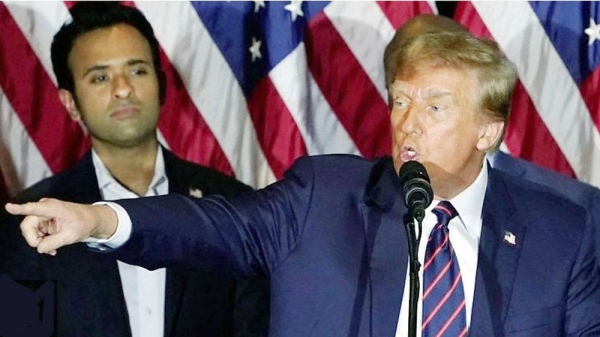
Jan 1 (Reuters) - The Omicron coronavirus variant dampened New Year festivities around much of the world, as cities from Paris to Kuala Lumpur cancelled civic celebrations, but London threw a last-minute party on television and Cape Town suddenly lifted a longstanding curfew.
The midnight hour passed in Paris without a planned fireworks display or DJ sets, as city officials cancelled events planned on the Champs-Elysees following the advice of a scientific panel that declared mass gatherings would be too risky.
Elsewhere around the globe, events were scaled back or cancelled outright, as with the traditional fireworks over the Petronas Towers in Kuala Lumpur. In the Netherlands, where outside groupings of more than four people are banned, police dispersed several thousand people who had defiantly gathered at Amsterdam"s central Dam Square, ANP news agency reported.
But in London, where a fireworks display and light show had been cancelled in October, officials announced on Friday the spectacle would come to life on the television screen, as Big Ben rang in the New Year for the first time since 2017 following a restoration.
"I"d encourage everyone to enjoy New Year"s in a sensible and cautious way, and the best way to do so is by watching the London show on TV," London Mayor Sadiq Khan told Sky News ahead of the event.
BBC images of the fireworks showed very light vehicle traffic and virtually no in-person spectators.
Earlier, Britain published a study of a million cases that found those with Omicron were around a third as likely to need hospitalisation as those with the previously dominant Delta variant. The results were "in keeping with the encouraging signs we have already seen," said Susan Hopkins, Chief Medical Adviser at the UK Health Security Agency.
Even so, many countries have reimposed restrictions to prevent healthcare systems from being overwhelmed.
The sudden arrival of Omicron has brought a surge in coronavirus case counts to countries around the world. Global infections hit a record high over the past seven-day period, with an average of just over a million cases detected a day worldwide between Dec. 24 and 30, up some 100,000 on the previous peak posted on Wednesday, according to Reuters data.
Deaths, however, have not risen in kind, bringing hope the new variant is less lethal.
In the wake of encouraging data, Cape Town abruptly lifted a curfew just in time for the New Year, after South Africa became the first country to declare its Omicron wave had crested - and with no huge surge in deaths.
A staff wearing a protective mask, amid the coronavirus disease (COVID-19) outbreak, takes picture of 6,500 candle lights as he prepares for a ceremony to wish for overcoming the pandemic and good luck in the upcoming New Year at Hasedera Buddhist temple in Kamakura, south of Tokyo, Japan, December 31, 2021. REUTERS/Kim Kyung-Hoon
A light display to mark the New Year is seen over St Paul’s Cathedral, amidst the spread of the coronavirus disease (COVID-19) pandemic, in London, Britain, January 1, 2022. REUTERS/Toby Melville
Fireworks explode in the sky over the Kremlin and St. Basil’s cathedral during the New Year"s celebrations in Moscow, Russia January 1, 2022. REUTERS/Tatyana Makeyeva
1/9
A light display to mark the New Year is seen over St Paul’s Cathedral, amidst the spread of the coronavirus disease (COVID-19) pandemic, in London, Britain, January 1, 2022. REUTERS/Toby Melville
South Africa had first raised the alarm about the new fast-spreading coronavirus variant racing around the world.
"I"m just hoping that Cape Town goes back to the old Cape Town that we all knew about," said Michael Mchede, manager of a Hard Rock cafe by the white sands of Camps Bay Beach, who was thrilled to find himself getting the place ready to host an unexpected bash.
Hours earlier, the Australian city of Sydney also feted the New Year with something like full swagger, as spectacular fireworks glittered in the harbour above the Opera House.
In New York, the glittering ball is still due to drop at Times Square, but the crowd counting down the year"s exit is set to be a quarter the usual size - masked up, socially distanced, and with vaccine proof in hand.
Just 15,000 spectators are being allowed into the official viewing area instead of the usual 55,000 or so - still a big upgrade from last year"s audience of a few dozen.
With New York state reporting more than 74,000 cases on Thursday and 22% of tests coming back positive, some critics wondered whether the celebrations should go ahead at all.
Revellers in Madrid queued for hours to get into the main Puerta del Sol square where celebrations went ahead with multiple security checkpoints, mandatory masks and capacity at 60% of normal levels.
Saul Pedrero, a 34-year old clerk, made the trip from Barcelona, which has some of Spain"s strictest controls, including a 1 a.m. curfew.
"It seems like another country. Here you can do everything and nobody says anything," he said.
A lavish firework display lit up the festivities, which Spaniards mark by stuffing 12 grapes into their mouths to accompany each chime of the clock striking midnight.
In Asia, celebrations were mostly scaled down or called off. In South Korea, a traditional midnight bell-ringing ceremony was cancelled for the second year, while festivities were banned in Tokyo"s glittering Shibuya entertainment district, and Prime Minister Fumio Kishida took to YouTube to urge people to wear masks and limit numbers at parties.
China, where the coronavirus first emerged in late 2019, was on high alert, with the city of Xian under lockdown and New Year events in other cities cancelled.












